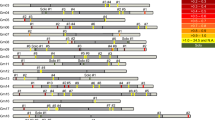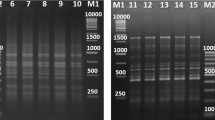Summary
Three families of retrotransposons of rice (Tos1,Tos2, andTos3) were isolated by using a method based on the sequence conservation of the primer binding site for reverse transcription. This method should be generally applicable for cloning retrotransposons of other plants. One retrotransposon,Tos3-1, was studied in detail.Tos3-1 is 5.2 kb long, has structures common to retrotransposons, such as long terminal repeats (LTR), a primer binding site complementary to the initiator tRNA, a polypurine tract, and generates target sequence duplications flanking the inserted element. Southern blotting analysis showed that sequences homologous toTosl, 2 and3 are found in wild rice species as well as in cultivated rice species, but not in maize and tobacco. The copy number and genomic location of the families vary in different strains of one species of wild rice, suggesting that these elements may still be active. Retrotransposons were also screened for by amplification of the reverse transcriptase coding region using the polymerase chain reaction (PCR). At least two types of copia-like elements (Tos4] andTos5) were found. The total copy number of retrotransposons in the rice genome was estimated to be about 1000. These results suggest that, as inDrosophila, retrotransposons are the major transposon class in rice.
Similar content being viewed by others
References
Aeby P, Spicher A, de Chastonay Y, Muller E, Tobler H (1986) Structure and genomic organization of proretrovirus-like elements partially eliminated from the somatic genome ofAscaris lumbricoides. EMBO J 5:3353–3360
Bingham P, Zachar Z (1989) Retrotransposons and the FB transposon fromDrosophila melanogaster. In: Berg DE, Howe MM (eds) Mobile DNA. American Society for Microbiology, Washington DC, pp. 485–502
Boeke JD, Garfinkel DJ, Styles CA, Fink GR (1985) Ty elements transpose through an RNA intermediate. Cell 40:491–500
Boeke J, Garfinkel DJ (1987) Yeast Ty elements as retroviruses. In: Leibowitz MJ, Koltin Y (eds) Viruses of fungi and simple eukaryotes. Marcel Dekker Inc, New Vork, pp. 15–39
Camirand A, St-Pierre B, Marineau C, Brisson N (1990) Occurrence of a copia-like transposable element in one of the introns of the potato starch phosphorylase gene. Mol Gen Genet 224:33–39
Chang TT (1984) Conservation of rice genetic resources: Luxury or necessity? Science 224:251–256
Clare J, Farabaugh P (1985) Nucleotide sequence of a yeast Ty element: evidence for an unusual mechanism of gene expression. Proc Natl Acad Sci USA 82:2829–2833
Coen ES, Robbins TP, Almedia J, Hudson A, Carpenter R (1989) Consequences and mechanisms of transposition inAntirrhinum majus. In: Berg DE, Howe MM (eds) Mobile DNA. American Society for Microbiology, Washington DC, pp. 413–436
Doolittle RE, Feng D-F, Johnson MS, McClure MA (1989) Origins and evolutionary relationships of retroviruses. Quart Rev Biol 64:1–30
Echalier G (1989)Drosophila retrotransposons: interactions with genome. Advances in virus research 36:33–103
Eichinger DJ, Boeke J (1988) The DNA intermediate in yeast Ty element transposition copurifies with virus-like particles: cell-free Tyl transposition. Cell 55:955–966
Fedoroff NV (1989) Maize transposable elements. In: Berg DE, Howe MM (eds) Mobile DNA. American Society for Microbiology, Washington DC, pp 375–411
Feinberg AP, Vogelstein B (1983) A technique for radiolabeling DNA restriction endonuclease fragments to high specific activity. Anal Biochem 132:6–13
Finnegan DJ (1985) Transposable elements in eukaryotes. Int Rev Cyt 93:281–326
Grandbastien MA, Spielman A, Caboche M (1989) Tntl, a mobile retrovirul-like transposable element of tobacco isolated by plant cell genetics. Nature 337:376–380
Green MM (1988) Mobile DNA elements and spontaneous gene mutation. In:Lambert ME, McDonald JF, Weinstein IB (eds) Eukaryotic transposable elements as mutagenic agents. Cold Spring Harbor Laboratory Press, New York, pp. 41–50
Harberd NP, Flavell RB, Thompson RD (1987) Identification of a transposon-like insertion in aGlu-1 allele of wheat. Mol Gen Genet 209:326–332
Iyengar GAS, Sen SK (1979) Characteristics of nuclear DNA in the genusOryza. Theor Appl Genet 54:219–224
Jin YK, Bennetzen JL (1989) Structure and coding properties ofBs1, a maize retrovirus-like transposon. Proc Natl Acad Sci USA 86:6235–6239
Johns MA, Babcock MS, Fuerstenberg SM, Fuerstenberg SI, Freeling M, Simpson RB (1989) An unusually compact retrotransposon in maize. Plant Mol Biol 12:633–642
Konieczny A, Voytas DF, Cummings MP, Ansubel FM (1991) A superfamily ofArabidopsis italiana retrotransposons. Genetics 127:801–809
Kröger B, Horak I (1987) Isolation of novel human retrovirusrelated sequences by hybridization to synthetic oligonucleotides complementary to the tRNAPro primer-binding site. J Virol 61:2071–2075
Kuff EL, Feenstra A, Lenders K, Smith L, Hawley R, Hozumi N, Shulman M (1983) Intercisternal A-particle genes as movable elements in the mouse genome. Proc Natl Acad Sci UAS 80:1992–1996
McCouch SR, Kochert G, Yu ZH, Wang ZY, Khush GS, Coffman WR, Tanksley SD (1988) Molecular mapping of rice chromosomes. Theor Appl Genet 76:815–829
Mellor J, Kingsman AJ, Kingsman SM (1986) Ty, an endogenous retrovirus of yeast? Yeast 2:145–152
Messing J (1983) New M13 vectors for cloning. Method Enzymol 101:20–89
Morishima H (1984) Wild plants and domestication. In: Tsunoda S, Takahashi N (eds) Biology of rice. Japan Science Press, Tokyo, pp. 3–30
Mount SM, Rubin GM (1985) Complete nucleotide sequence of theDrosophila transposable element copia: homology between copia and retroviral proteins. Mol Cell Biol 5:1630–1638
Murray MG, Thompson WF (1980) Rapid isolation of high-molecular-weight plant DNA. Nucleic Acids Res 8:4321–4325
Paulson KE, Deka N, Schmid CW, Misra R, Schindler CW, Rush MG, Kadyk L, Leinwand L (1985) A transposon-like element in human DNA. Nature 316:359–361
Rubin GM (1983) Dispersed repetitive DNAs inDrosophila. In: Shapiro JA (ed) Mobile genetic elements. Academic Press, New York, pp. 329–361
Saigo K, Kugimiya W, Matsuo V, Inouye S, Yoshinaka K, Yuki S (1984) Identification of the coding sequence for a reverse transcriptase-like enzyme in a transposable genetic element inDrosophila melanogaster. Nature 312:659–661
Sambrook J, Fritsch EF, Maniatis T (1989) Molecular claning: A laboratory manual, 2nd edn. Cold Spring Harbor Laboratory Press, Cold Spring Harbor, New York
Shepherd NS, Schwarz-Sommer Z, vel Spalve JB, Gupta M, Wienand U, Saedler H (1984) Similarity of theCinl repetive family ofZea mays to eukaryotic transposable elements. Nature 307:185–187
Shepherd RJ (1989) Biochemistry of DNA plant viruses. In: Marcus A (ed) The biochemistry of plants. Academic Press, San Diego pp. 563–616
Shimamoto K, Terada R, Izawa T, Fujimoto H (1989). Fertile transgenic rice plants regenerated from transformed protoplasts. Nature 337:274–276
Smyth DR, Kalitsis P, Joseph JL, Sentry JW (1989) Plant retrotransposon fromLilium henryi is related toTy3 of yeast and the gypsy group ofDrosophila. Proc Natl Acad Sci USA 86:5015–5019
Sprinzl M, Hartman T, Meissner F, Moll J, Vorderwulbecke T (1987) Compilation of tRNA sequences and sequences of tRNA genes. Nucleic Acids Res 15:Suppl r53-r188
Takahashi N (1984) Differentiation of ecotypes inOryza sativa L. In: Tsunoda S, Takahashi N (eds) Biology of rice. Japan Science Press, Tokyo, pp. 31–67
Toh H, Kikuno R, Hayashida H, Miyata T, Kugimiya W, Inouye S, Vuki S, Saigo K (1985) Close structural resemblance between putative polymerase of aDrosophila transposable genetic element 17.6 andpol gene product of Moloney murine leukemia virus. EMBO J 4:1267–1272
Varmus H, Brown P (1989) Retroviruses. In: Berg DE, Howe MM (eds) Mobile DNA. American Society for Microbiology, Washington DC, pp. 53–108
Végh Z, Vineze E, Kadirov R, Tóth G, Kiss GB (1990) The nucleotide sequence of a nodule-specific gene, Nms-25 ofMedicago sativa: its primary evolution via exon-shuffling and retrotransposon-mediated DNA rearrangements. Plant Mol Biol 15:295–306
Voytas DF, Ausubel FM (1988) A copia-like transposable element family inArabidopsis thaliana. Nature 336:242–244
Author information
Authors and Affiliations
Additional information
Communicated by D.J. Finnegan
Rights and permissions
About this article
Cite this article
Hirochika, H., Fukuchi, A. & Kikuchi, F. Retrotransposon families in rice. Molec. Gen. Genet. 233, 209–216 (1992). https://doi.org/10.1007/BF00587581
Received:
Issue Date:
DOI: https://doi.org/10.1007/BF00587581




